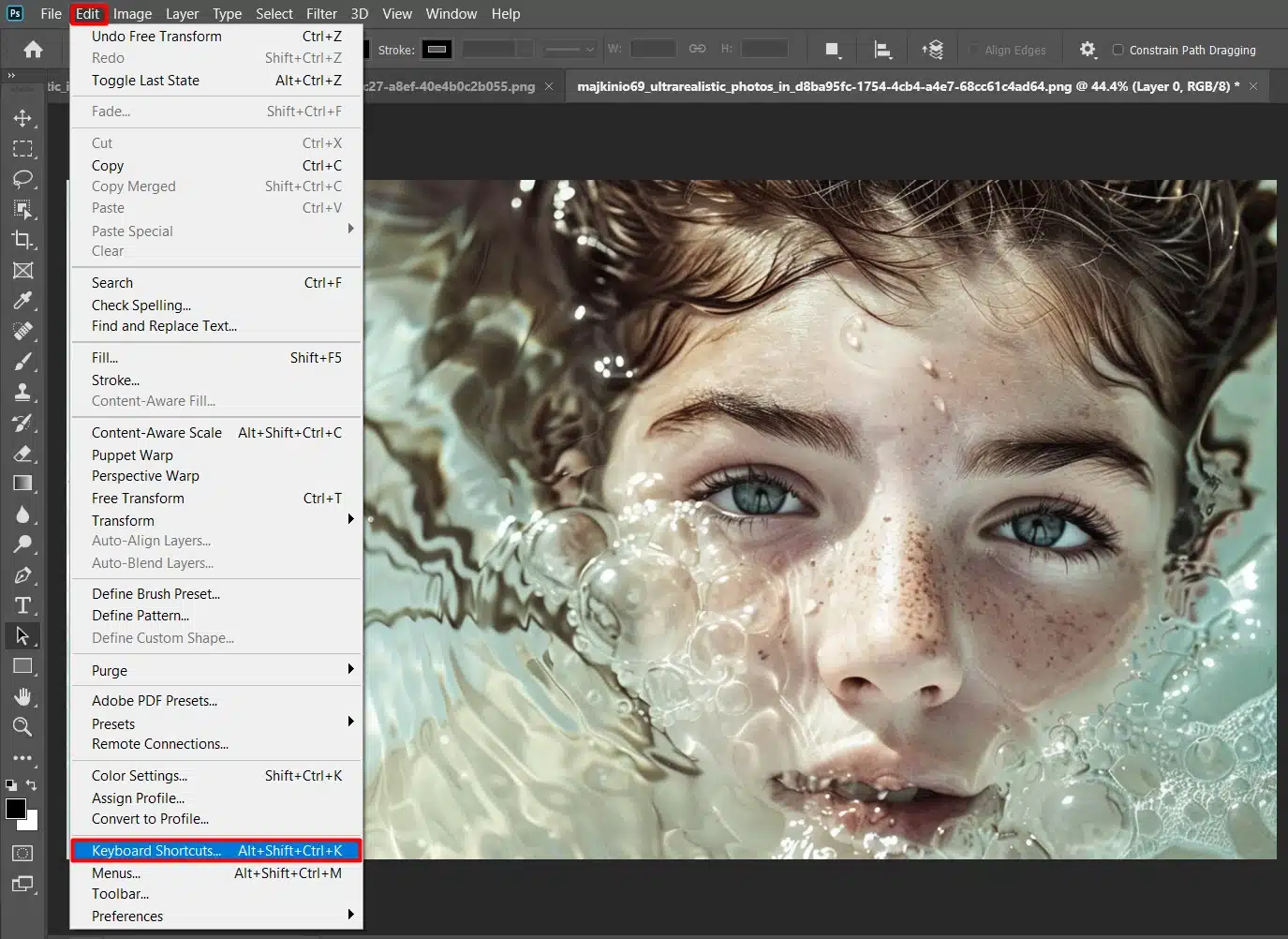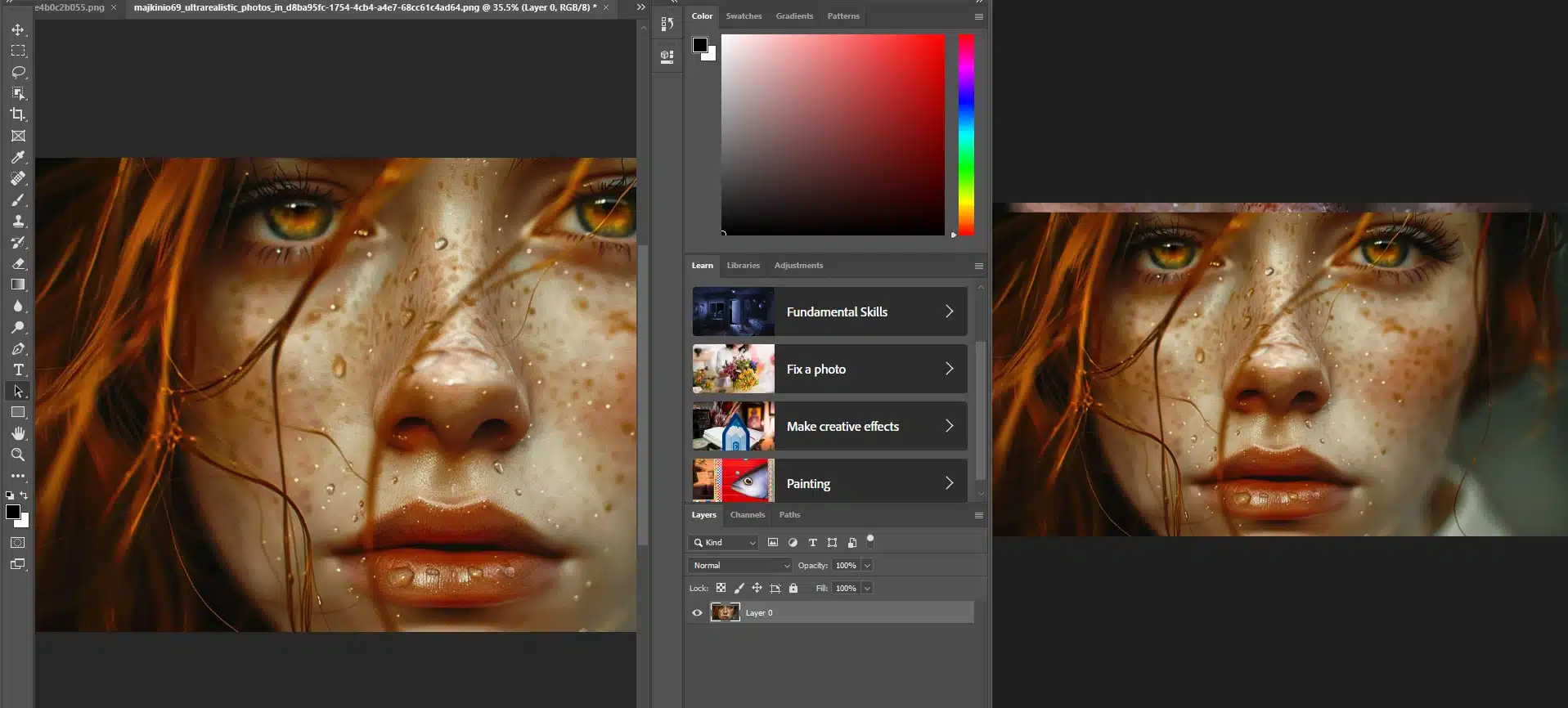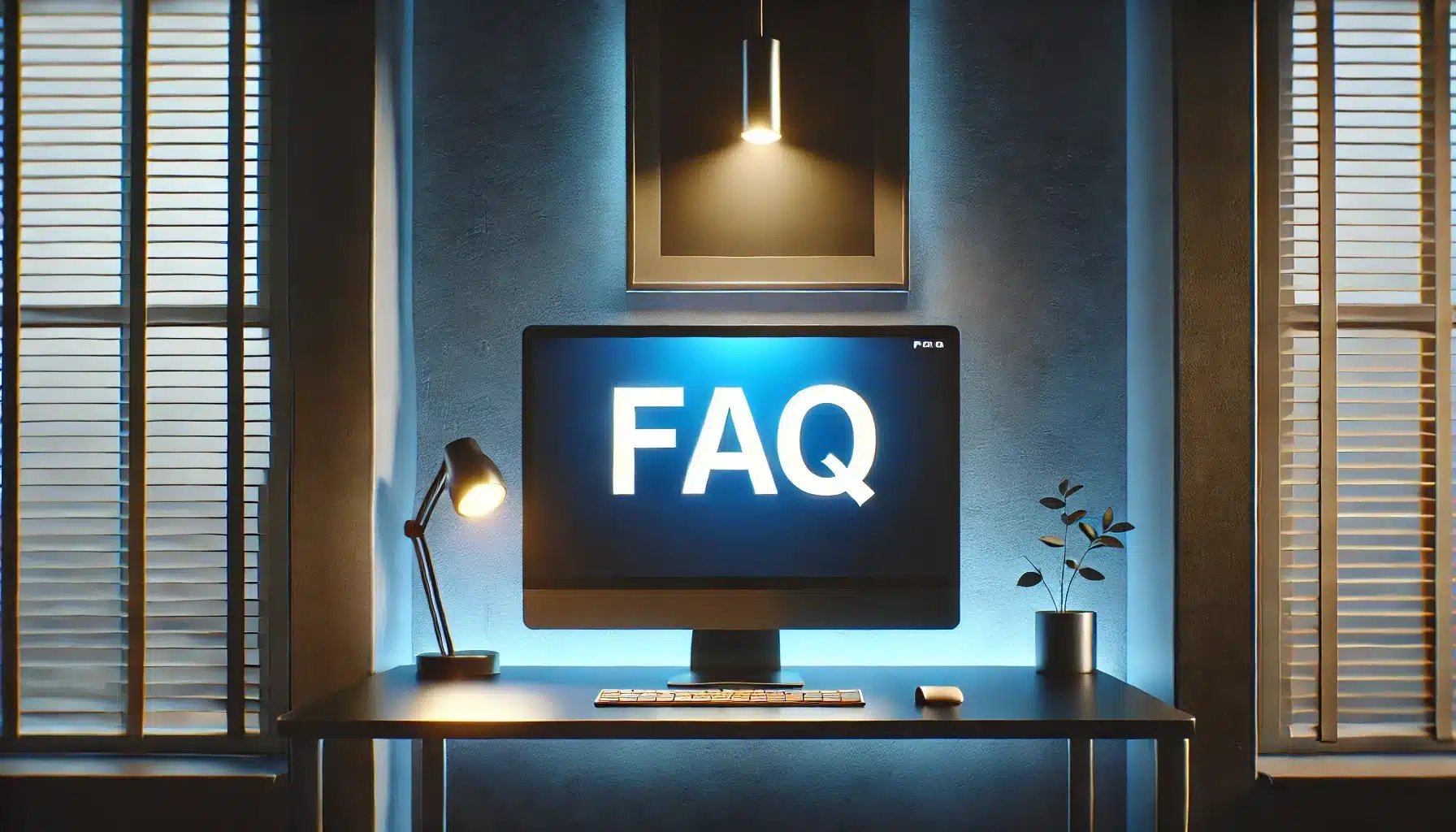
Photoshop full screen exit is essential whether immersed in detailed edits or switching back to a clutter-free workspace.
Mastering full screen mode can significantly enhance your workflow when diving into Photoshop.
In this guide, I’ll walk you through the various screen modes, how to navigate them, and the quickest ways to return to your standard View.
Ready to streamline your editing process? Let’s get started!
Table of Contents
How to Exit Out of Photoshop Full Screen
We all enjoy using Photoshop’s full screen mode. But sometimes, we need to get back to our tools and panels.
Photoshop full screen exit: How do we exit this view? Here’s a simple guide.
Quick Solutions for Photoshop Full Screen Exit
To make that Photoshop full screen exit, First, hit Esc. This will return your screen to its previous state.
If pressing Esc doesn’t work, use the View Menu. Go to View, select Screen Modes, and choose Standard Screen Mode.
This will bring back your workspace with all panels and menus visible.
Other Methods for Photoshop full screen exit
If you accidentally activate the full screen mode with menu bar screen mode, hit Shift + F a few times. Each press cycles through different screen modes until you return to the standard mode.
If these methods don’t work, try the Tab key.
Pressing the Tab key hides and shows the toolbar and panels. Press it once to hide, and again to display.
This can be particularly useful when working in full screen mode. This technique is effective across any screen mode in Photoshop.
Pro Tip: Save your work regularly. Exiting full screen mode can sometimes disrupt your flow.
Keeping your document saved ensures you don’t lose any edits. This is especially important when switching screen mode in Photoshop.
Additional Tips for Photoshop Full Screen Exit
While working in Photoshop, it’s helpful to familiarize yourself with essential tools and various Photoshop shortcuts.
These can significantly enhance your workflow and efficiency, especially when switching in and out of full screen mode or any other screen mode.
Understanding Photoshop Screen Modes
Photoshop offers various screen modes to optimize your workspace and enhance your editing experience.
Understanding these screen modes allows you to customize your view for different tasks, whether you need a clutter-free workspace or quick access to tools and panels.
Where To Find The Screen Modes
To find Photoshop’s screen modes, go to the View menu at the top. You’ll see options to adjust your viewing preferences, including full screen mode.
Hover over the toolbar icons for quick identification.
In this guide, I’ll walk you through the various screen modes, how to navigate them, and the quickest ways to return to your standard View. Ready to streamline your editing process?
Let’s get started!
Standard Screen Mode
The standard screen mode shows your document in a typical document window view. It’s great for routine edits because all panels, menus, and the toolbar are visible. If you switch views by mistake, hit the F key to return to this mode.
This mode might look cluttered, but everything you need is right there. However, switching to full screen mode can help reduce distractions when you need to focus.
Full Screen Mode

Full Screen Mode maximizes your workspace by removing distractions. Hit Shift + F to enter full screen mode. Your image will fill the entire full screen without panels or the menu bar.
This is ideal for detailed edits and focus sessions. Hit Esc to exit this mode.
Full Screen Mode with Menu Bar
For a wide view with menu access, use Full Screen Mode with Menu Bar. You get a full screen mode view while keeping the top menu available. This mode balances productivity and a wide image view.
Pro Tip: Customizing keyboard shortcuts for screen modes can speed up your workflow. Assign intuitive keys to switch modes without breaking your creative flow.
Full Screen Mode With Menu Bar
Your image fills the screen, but you still have the menu bar. This means you can quickly access all essential tools. If you make a mistake or need a tool, it’s right there.
To activate this full screen mode screen mode, hit Shift + F.
Accessing The Interface From The Sides
In full screen mode, accessing the interface might seem tricky. Just hover your mouse near the edges of your screen. Your panels and toolbar will slide in from the sides.
They’re hidden away, but come back when you need them. This screen mode is particularly useful when using essential tools in Photoshop in full screen mode.
Showing The Toolbar In Full Screen mode

Missing your toolbar? Hit the Tab key. This brings back the toolbar and other hidden elements in full screen mode.
Use it again to hide them. It’s a great way to focus on your work while having tools a click away.
Knowing these Ligtroom shortcuts can significantly improve your workflow, especially when working in full screen mode or any other screen mode.
Showing The Panels In Full Screen mode
Like the toolbar, your panels can disappear in full screen mode.
Need them back? Press Tab, and they’re back on your screen. Want them gone again?
Press the Tab once more. Quick and easy!
This method works seamlessly in full screen mode, ensuring your workspace is efficient and clutter-free in any screen mode.
Pro Tip: Customize your shortcuts for switching screen modes. This makes it faster to navigate through different views without missing a beat.
How to Enter Full Screen Mode
If you want to focus on your images without distractions, entering full screen mode is the way to go.
Here’s how to do it easily.
Using Keyboard Shortcuts
Keyboard shortcuts are handy in Photoshop. To quickly enter full screen mode, press Shift + F.
This combo will cycle through different screen modes: full screen mode, standard screen mode, and screen mode with menu bar.
- Standard Screen Mode: All panels, menus, and the toolbar are visible.
- Full Screen Mode With Menu Bar: Your image fills the screen, but the menu bar stays at the top.
- Full Screen Mode: Everything else disappears, letting you focus entirely on your image.
It’s quick and easy, and before you know it, you’re lost in your work without other elements to distract you.
Using the View Menu on Full screen mode
If you don’t like remembering shortcuts, no worries! Photoshop has you covered with the View menu. Here’s what to do: navigate to the View menu to access different screen modes, including full screen mode, standard screen mode, and screen mode with the menu bar.
- Go to the top of the screen and click on View mode.
- Hover over Screen Mode.
- Select Full Screen Mode or Full Screen Mode With Menu Bar as needed.
This way, you control what parts of the interface you want to display while working on your document, adjusting screen modes and the visibility of the menu bar as needed.
Summary: Now that you know how to switch between different screen modes using shortcuts and the View menu, you’ll find it easier to navigate Photoshop.
Whether you’re editing photos for fun or working on a detailed project, these tips will help you stay efficient, managing screen modes and adjusting the visibility of the menu bar as necessary.
Pro Tip: If you ever find yourself stuck and need to leave full screen mode, just press the Esc key or switch back using the View menu.
This ensures you can always go back to the standard screen mode and access all your tools and panels, managing screen modes and adjusting the visibility of the menu bar as necessary.
Additional Tips: For those looking to enhance their workflow further, consider learning more about how to use manual mode a comprehensive Beginner’s Guide.
Mastering these can significantly speed up your editing process, make your experience more enjoyable, and efficiently manage screen modes.
How to Exit Full Screen Mode
In Photoshop, full screen mode can be handy. But sometimes, you need to get back to the regular view mode. How do you do this? Let’s find out.
Using Keyboard Shortcuts for Full Screen Mode
When you’re working and full screen mode isn’t cutting it, press the Esc key. This will get you back to the standard screen.
If that doesn’t work, try Shift + F. This combo switches between different screen modes, including standard and full screen mode with menu bar.
It’s quick and returns to your usual setup, managing screen modes efficiently.
Using the View Menu
Not into shortcuts? No problem. You can also leave full screen mode using the view menu at the top. Here’s how:
- Click on View mode at the top of your screen. This opens a list of options.
- Hover over Screen Mode and select Standard Screen Mode. Your screen will go back to the usual layout with all panels and tools visible.
Using the menu (View) might take a second longer, but it’s great if you like using menus. Plus, it always works for managing screen modes efficiently.
Pro Tip: If your panels or toolbar are hidden, press Tab. This will bring them back in any mode, including standard screen mode and other screen modes. It’s a lifesaver for managing screen modes efficiently!
For even more tips on enhancing your editing workflow, consider Adobe Lightroom training to complement your Photoshop skills and learn more efficient techniques for photo editing. Understanding the difference between Photoshop and Lightroom can help you choose the right tool for your editing needs.
View Menu in photo editing software, you can easily streamline your actions for portraits This feature enhances workflow efficiency by allowing quick access to essential tools and adjustments for portrait editing.
Troubleshooting Common Issues
Whether you’re dealing with technical glitches, configuration errors, or user-related issues, this guide aims to help you diagnose and fix these common challenges efficiently.
Keyboard Shortcuts Not Working

If your shortcuts stop working in Photoshop, don’t worry. First, check if your keyboard is connected correctly.
Sometimes, other applications might hijack these shortcuts; closing unnecessary apps can help.
If Photoshop itself has a glitch, restarting the application often helps. Go to Edit > Keyboard Shortcuts to customize or reset them to default if that fails.
Your graphics card drivers might also need an update. Check for the latest updates and install them.
Pro Tip: Regularly save and back up custom shortcuts to avoid future hassles.
For those looking to dive deeper into Photoshop’s capabilities, understanding blending modes is essential.
They can enhance your editing by combining layers in various ways. Check out this guide on blending modes in Photoshop to take your skills to the next level.
Menu Bar Not Visible
Is your menu bar missing in full screen mode?
Hit the F key to toggle through different screen modes.
If pressing F doesn’t work, try Shift + F until the correct view mode appears. Another trick is going to Menu (View) > Screen Mode > Standard Screen Mode.
This should bring all your tools back into view mode.
If you’re still having trouble, resetting your workspace by going to Window > Workspace > Reset can solve the issue.
Pro Tip: Use the Tab key if you lose sight of your toolbar or panels. It can hide and unhide them in any screen modes.
Photoshop vs. Lightroom: Which One to Choose?
When deciding between Photoshop and Lightroom, it’s important to understand their strengths and ideal use cases. Here’s a quick comparison to help you choose the right tool for your editing needs:
| Aspect | Overview |
|---|---|
| Photoshop | Ideal for detailed and complex edits. Best for graphic design and compositing. |
| Lightroom | Great for batch processing and organizing photos. Perfect for photographers with large libraries. |
| Pro Tip | Use both for a comprehensive workflow—Lightroom for basic adjustments, Photoshop for intricate edits. |
When deciding between photoshop vs. lightroom, consider your editing needs.
Photoshop offers extensive tools like the content-aware fill and patch tool for detailed edits and options to switch screen modes and ensure the standard screen mode works smoothly.
On the other hand, Lightroom excels in batch processing and non-destructive edits, making it ideal for photographers handling large volumes of images.
Pro Tip: Use both tools in tandem for a comprehensive editing workflow. Start with Lightroom for basic adjustments and move to Photoshop for intricate edits.
Extra Tips and Tricks
Beyond standard solutions, these additional tips and tricks offer innovative and efficient methods to optimize performance, enhance productivity, and prevent common issues.
Whether you’re aiming to boost efficiency, increase precision, or explore advanced strategies, these practical suggestions will help you get the most out of your tools and resources.
Customizing Screen Modes
Photoshop has different screen modes that can make your editing easier. You can change these modes to fit your needs. Go to the menu (View) at the top and select Standard Screen Mode.
Choose between Standard, Full Screen with Menu Bar, and Full Screen. Use Shift + F to switch modes quickly.
- Standard Mode: You see everything: panels, tools, and menus. It's a bit crowded but useful for quick edits.
- Full Screen Mode with Menu Bar: Gives you more space while keeping top options available.
- Full Screen Mode: Hides everything but your image – great for focusing.
Switching view mode can become a habit. Find what works best for your tasks and edit preferences accordingly.
One shortcut can save you lots of time!
Pro Tip: Assign unique shortcuts for each mode. It makes your workflow smoother and less interrupted but also helps when you need to quickly switch screen modes to optimize web image quality, ensuring that your images are displayed perfectly on different devices.
Using Multiple Screens

Editing photos in Photoshop and Lightroom is easier with multiple screens. It’s like upgrading from a bike to a race car. More screens allow space for your document window, panels, and toolbars, ensuring standard screen mode works smoothly for efficient editing.
Follow these steps to use multiple screen:
- Put Photoshop on one screen in full screen mode.
- On the second screen, keep your email or reference images open.
- Drag your application windows to the other screen. Voilà! You see changes in real-time without clutter.
This way, you avoid toggling between windows and focus more on your work.
Pro Tip: Using different screens boosts productivity. It helps you keep track of various elements without clutter.
Insights into optimizing your workflow with different tools and software and understanding of photography terminology and concepts, consider exploring different digital cameras and our glossary of photography to understand how varying equipment can enhance your creative output.
Frequently Asked Questions (FAQs)

How do I leave full screen mode?
Hit the Esc (Escape) on your keyboard to leave full screen mode.
How do I leave the entire screen in Adobe?
Easy steps to leave the entire screen:
- In Adobe applications, you can leave full screen mode by pressing the F key repeatedly until you return to the standard view mode.
- Alternatively, hit the Esc key.
How do I exit the full screen on my Mac?
- Move your cursor to the top of the screen to reveal the menu bar.
- Click on the green full-screen button in the top-left corner of the document window or hit Control + Command + F.
How to get panels back in Photoshop?
Few steps to het the panels back:
- Go to the document Window menu in the top menu bar.
- Select the panels you wish to see, such as Layers, Channels, or Paths.
Conclusion
Discovering how to swiftly switch between screen modes in Photoshop, including full screen mode and standard screen mode, has revolutionized my editing workflow.
Using shortcuts like Esc or Shift + F allows me to stay focused on detailed tasks without navigating complex menus.
If you want to improve your editing skills, explore my Photoshop Course and Lightroom Courses. Mastering these tools enhances efficiency and unleashes creativity.
Dive deeper into Adobe’s Photoshop and Photoshop Lightroom products to optimize your editing experience.
Happy Editing!
Read more about Photoshop:
















